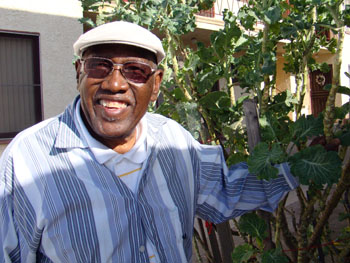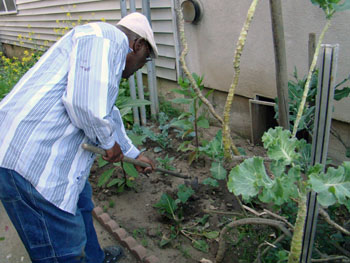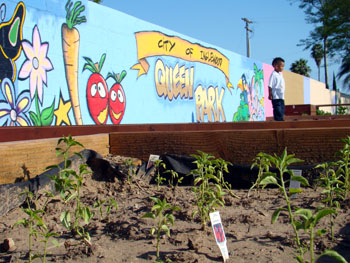When Frank Scroggins helped his family grow cotton, corn and watermelon on a few acres of farmland during the tail end of the Great Depression in Shreveport, Louisiana, he never thought he would find himself a small-space grower in concrete-laden Inglewood. 
For nearly four decades, Scroggins, 77, has maximized his small, half-acre yard to grow heaps of tomatoes, peas, mustard, chard, cucumbers, turnips and his favorite three varieties of collard greens. Several months ago, he took part in launching the Queen Park Learning Garden across the street from his home.
“I prayed to God for something like this to happen,” said Scroggins. “It’s hard to get kids interested, but we want to get more young people involved.”
 Scroggins and his Queen Street neighbors considered the idea of a community garden for years, although the nearby park was a challenge because of its rundown facilities. In March, they got their chance: Queen Park received a makeover with new playground equipment from KaBOOM!, a Disney-sponsored nonprofit that creates playgrounds in low-income residential areas.
Scroggins and his Queen Street neighbors considered the idea of a community garden for years, although the nearby park was a challenge because of its rundown facilities. In March, they got their chance: Queen Park received a makeover with new playground equipment from KaBOOM!, a Disney-sponsored nonprofit that creates playgrounds in low-income residential areas.
“Our model is to partner with people who want it,” said D’Artagnan Scorza, director of the Social Justice Learning Institute, which provides gardening resources to Inglewood residents. “I don’t want us to run gardens. I want people to run these gardens for themselves.”
A core group of 15 Inglewood residents manages the Queen Park Learning Garden through weekly committee meetings, events and maintenance schedules. The committee’s event on Earth Day drew nearly 300 guests, 20 of whom signed up for committee involvement.
Despite a rich, agricultural past, Inglewood is one of many communities identified as a food desert: an area which lacks adequate access to fresh produce and instead, offers an abundance of liquor stores and fast food restaurants. Now with a population of 130,000, Inglewood was incorporated in 1908 with most of the land used for farming through the 1930s. After the Great Depression, most farmland gave way to industrialization and buildings that still stand along Manchester Boulevard.
By the time Scroggins arrived in 1974, he was the exception to the rule for growing his own food. Now, he hopes more residents will take part in the practice through the Queen Park Learning Garden.
“[My children] go with me on Saturdays to water, and my two-year-old loves that because he always likes to hold the hose,” said Maygan Marie-Orr, an Inglewood resident, teacher and committee member. “They have a good time trying to identify the plants, like, ‘Oh, that’s squash. Those are peppers.'”
Marie-Orr and the committee are designing a curriculum to engage students in the entire process of growing food: preparing soil, planting, maintenance and harvesting for maximum yield. So far, they have grown more than two dozen varieties of vegetables and herbs. 
Los Angeles County is home to 73 community gardens, most of which serve gardeners who have annual incomes below $25,000, according to the UC Cooperative Extension Common Ground Program, which trains gardeners to provide nutrition and growing education to low-income areas. They report that 64 percent of their gardeners make less than $15,000 per year.
“There will always be a much greater need than all of our collective agencies and efforts that are made out there,” said Yvonne Savio, Common Ground Program manager. “But more is always better when it comes to lots of information and helping people.”
The Common Ground Program was created in 1978 when the U.S. Department of Agriculture identified 20 major metropolitan cities that would use funding to help low-income communities grow their own food. The funds for Los Angeles went primarily toward establishing the Common Ground Program and ten low-income housing developments that contained community gardens. When Savio was hired in 1994, most of the housing development gardens had dwindled to non-existence due to lack of maintenance, and federal funding had steadily decreased over the years.
However, agency-funded assistance isn’t always what community members may desire for improving their food system.
“People always talk about low-income communities wanting to rely on welfare and handouts,” said Scorza. “But I always know that’s a misnomer or a misunderstanding of what’s really going on in these communities. Most communities do want help, but they want help so that they can do it for themselves.”
Still, free food programs remain the prime way residents of food desert communities receive fresh produce. As of the 2010 Census, the U.S. Department of Agriculture estimates that one in seven Americans receive food stamps, totaling 44.2 million recipients. In February 2011, more than 9.7 percent of California’s roughly 37 million residents received food stamps.
The Los Angeles Food Bank provides food for those who may not qualify for food stamps but still lack adequate funds or access to food. Through a partnership with the nonprofit Feeding America, the bank provided more than 62 million pounds of food last year, 20 percent of which came from central California farmers. However, the program has to formally team up with urban growing programs.
“It’s definitely something that could reduce the dependency on food banks and pantries if we can get more of these out there,” said Darren Hoffman, communications director for Los Angeles Food Bank. He noted that the 14-acre South Central Farm, which used to sit across the street from the bank, was a promising source of sustainable food production until it closed several years ago after a change in land ownership. The farm has since relocated closer to Bakersfield.
“We’re looking into more ways to find more sustainable ways for people to get their food, but it’s tough to try to find that time and synergies where we can link with this or that group or get more people out there growing their own food,” said Hoffman, adding that policy changes are often more effective on a large scale than individual projects.
Even though small-scale gardening groups continue to crop up across food desert neighborhoods, policy groups, too, are slow to integrate with these initiatives.
“Unfortunately, I am not aware of any relationship between the effectiveness of urban farming initiatives and the federal nutrition programs,” wrote Matthew Sharp, a senior advocate with California Food Policy Advocates, in an e-mail. “There isn’t much connection between our policy work and the impressive, neighborhood-level garden and urban agriculture projects.”
So far this year, the organization has proposed several state bills to improve nutrition education in underserved communities, such as the Putting Breakfast First Act, which would provide $350 million to California public schools to offer healthy breakfast as an alternative to sitting on an empty stomach until lunch time or snacking on junk food in between.
Large-scale programs aside, community gardeners insist that small-scale initiatives are the most effective way to educate about nutrition and health on an individualized basis. 
“Community buy-in is number one,” said Marie-Orr, who pointed out that the desire for healthier nutrition standards has been a regular conversation topic in her Inglewood neighborhood. The Queen Park Community Garden is only a few months into operation, but several vegetables are being harvested, such as beets, lettuce and several herbs.
“When I get a garden, then I’m going to grow strawberries everywhere and then pick them and eat them,” said 3-year-old Brooklyn Milliner, whose mother brings him to Queen Park to play now that the playground has been renovated.
Longtime neighbors like Scroggins were not accustomed to seeing the no-smoking signs and colorful murals that now stand prominently at Queen Park.
“If we can just keep the gang bangers out of here, this park can be for the kids,” said Scroggins, who recalled that a young man was shot and killed in front of his home a few years ago. “To tell you the truth, it’s been nicer here since they put in the whole park.”














